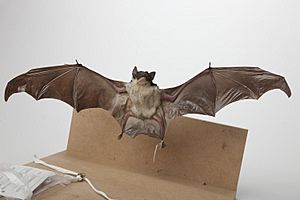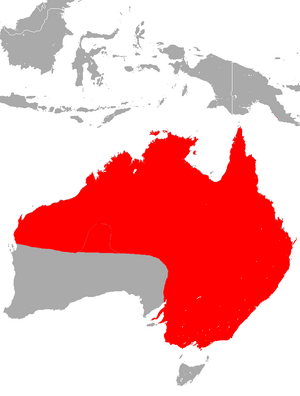Yellow-bellied sheath-tailed bat facts for kids
Quick facts for kids Yellow-bellied sheath-tailed bat |
|
|---|---|
 |
|
| Conservation status | |
| Scientific classification | |
| Genus: |
Saccolaimus
|
| Species: |
flaviventris
|
 |
|
| Yellow-bellied sheath-tailed bat range | |
The yellow-bellied sheath-tailed bat (Saccolaimus flaviventris) is a type of microbat. It is also known as the yellow-bellied sheathtail or yellow-bellied pouched bat. This bat belongs to the Emballonuridae family. You can find it mostly in Australia and sometimes in parts of Papua New Guinea.
Even though these bats live across most of Australia, we don't know much about their daily lives. This is because microbats are small, active at night, and hard to find. They are sometimes confused with other similar bats, but they look quite different up close. The yellow-bellied sheath-tailed bat is the only microbat known to carry a virus called Australian bat lyssavirus.
Contents
About the Yellow-bellied Sheath-tailed Bat
The first person to describe this bat was Wilhelm Peters in 1867. He used a bat that G. R. Waterhouse had given to John Gould.
This bat is part of a group called Microchiroptera, which means "insect-eating microbats." It is the biggest Australian bat in the Emballonuridae family. Bats in this family have a special tail that is partly covered by a membrane, like a sheath. That's why they are called "sheathtails." There are eight known sheathtail species in Australia. In Australia, this family is split into two main groups: Taphozous and Saccolaimus. The yellow-bellied sheath-tailed bat is one of only four Saccolaimus bats known worldwide.
What Does This Bat Look Like?
The yellow-bellied sheath-tailed bat is quite large for a microbat. It usually weighs about 44 grams, but can be between 28 and 60 grams. Its body, from head to tail, is about 81.8 millimeters long.
It has very clear fur colors. Its back is a shiny jet black, and its belly is a creamy white. Male bats have a special pouch on their throat called a gular pouch. Scientists think this pouch helps them mark their territory. Female bats do not have this pouch; instead, they have bare skin folds around their throats. Unlike some other sheathtail bats, this species does not have a wing pouch.
Other features that help identify this bat include a flat head and a pointy nose. Its forearm is about 74–77 millimeters long.
Where Do These Bats Live?
The yellow-bellied sheath-tailed bat seems to live in many places. It is found across most of eastern and northern Australia. It's hard to know exactly how many there are because they are difficult to catch and spot. We often learn about where they live from accidental sightings. For example, one bat was found mummified on a fence in central western Queensland.
These bats are most common in tropical areas. However, they also live in dry, semi-arid places. This includes the Mallee region in Victoria, Gundabooka National Park in New South Wales, and central-western Queensland. They likely migrate to cooler southern parts of Australia during the summer. Records show them in Victoria, New South Wales, and South Australia during certain seasons.
Although less common, two yellow-bellied sheath-tailed bats have been found in Papua New Guinea.
These bats live in most wooded areas. This includes wet and dry sclerophyll forest, mallee and Acacia shrubland, deserts, and open woodlands. They like to roost in hollows, so they are often found near old, large trees.
Bat Behavior and Lifestyle
Where Bats Rest and Sleep
Not many studies have looked closely at where these bats rest. Yellow-bellied sheath-tailed bats usually roost in tree hollows found in old-growth forests. But they can also use other spots if needed. They have been seen resting in old animal burrows or human buildings. Sometimes, single bats will roost under dry clay or rocks.
These bats are mostly solitary, meaning they like to be alone. Sometimes, they might roost in small groups of 2 to 10 bats, with both males and females. A special case was the Brightview colony found in Queensland in 1996. This group was found by accident when an old tree was cut down. It had 29 bats, which is the largest group of yellow-bellied sheath-tailed bats ever recorded.
Seasonal Movements
We don't have full proof, but yellow-bellied sheath-tailed bats might migrate. This is based on local records that show them only at certain times of the year. We don't know their exact travel routes. However, observations suggest they move to cooler southern parts of Australia in the summer. Their long, narrow wings are good for long flights, which supports the idea of migration. Also, tired bats sometimes appear in Victoria and South Australia during these seasons.
What Do These Bats Eat?
Yellow-bellied sheath-tailed bats are canopy feeders. This means they fly fast but are not very good at quick turns. They usually hunt for food high up, about 20–25 meters in the air. But they will fly lower in open areas or at the edges of forests.
Scientists have studied what's in their stomachs. They found that these bats eat Orthoptera (like grasshoppers), Coleoptera (beetles), and Hemiptera (true bugs). Beetles make up most of their diet.
Reproduction and Life Cycle
Female yellow-bellied sheath-tailed bats start getting ready to breed in August. Their right uterine horn grows bigger, reaching its largest size in November. They usually have one baby between December and March. Their mammary glands (milk-producing glands) shrink by the end of May.
How These Bats Fly
Yellow-bellied sheath-tailed bats have a special way of flying. They fly fast and in a straight line, with slow wing beats. This unique flight pattern, along with their light-colored belly fur, makes them easy to spot when flying. Their long, narrow wings and large body allow them to fly very fast. However, they are not very agile. This makes them best suited for flying high in the tree canopy or in open spaces.
Bat Physiology
The yellow-bellied sheath-tailed bat is a nocturnal animal, meaning it is active at night. They seem to be most active about an hour after dark, but only for a few hours. Many bats in the Emballonuridae family can save energy by going into a state of torpor. This is like a short, deep sleep where their body temperature and heart rate drop.
Communication and Behavior
Like all microbats, the yellow-bellied sheath-tailed bat uses echolocation to communicate and find its way. This means they make sounds and listen for the echoes. Some of these sounds are loud enough for humans to hear. Scientists have recorded different sound patterns linked to different behaviors. For example, specific sounds are used for hunting, catching prey, or defending their territory. These bats have also been seen fighting each other in the air.
Protecting These Bats
Even though we don't see the yellow-bellied sheath-tailed bat very often, its conservation status is listed as "least concern." This means scientists believe it is not at high risk of disappearing. This is because the bat lives in many places and can adapt to different habitats.
However, some states in Australia are more careful about its status. This is likely because we don't have enough information about their populations. For example, in New South Wales, it is listed as vulnerable. In South Australia, it is considered rare. In Victoria, it is listed as threatened.
The biggest dangers to the yellow-bellied sheath-tailed bat are losing their habitat, especially old trees with hollows. Disturbances to their roosting sites are also a threat. Another danger is when their food sources (insects) become scarce or are poisoned by pesticides and herbicides.
- Chiroptera Specialist Group 1996. Saccolaimus flaviventris. 2006 IUCN Red List of Threatened Species. Downloaded on 10 July 2007.
- Barrett, Janine L. (2004) "Australian Bat Lyssavirus." PhD thesis, The University of Queensland. Australian Bat Lyssavirus - DAFF eResearch Archive (eRA)


